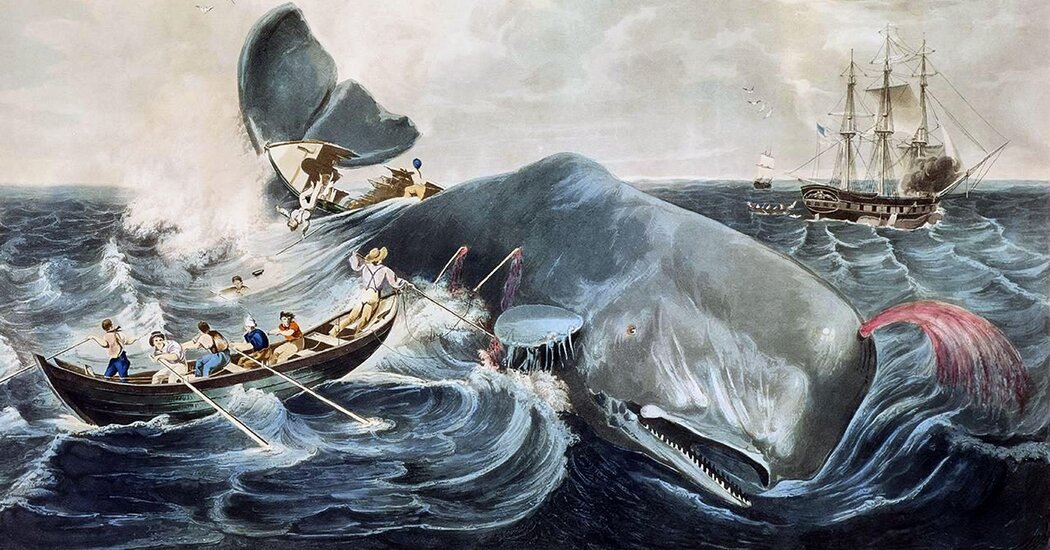When “Moby-Dick” opens at the Metropolitan Opera this week, audiences will experience a deeply American story of unchecked ambition, fomented grievances and a self-destructive desire for revenge.
Based on Herman Melville’s 1851 novel, the opera delivers an economical and resolute retelling of the fateful tale of the Pequod, a ship in pursuit of a vengeful white whale. The libretto, by Gene Scheer, hits the book’s main conflicts without losing track of the action. The score, by Jake Heggie, is graceful and propulsive. The opera’s ending is certain and clear.
It’s probably fair to say that more people know the story of the white whale from parodies or synopses than from reading “Moby-Dick.” But an adaptation is not just a summary of the book’s major events. A society obsessed with efficiencies can be overly focused on directness.
Skillful though it is, the opera, which had its premiere at the Dallas Opera in 2010, has a kind of scrubbed and airless storytelling that leaves the singularity of the novel behind. This is the sort of adaptation that audiences have long responded to — a simplification of the book’s billowy structure to emphasize its plot. But can a tidy adaptation truly represent this unruly book, with its dramas born of endless uncertainties? Or is the purpose of adaptation something different?
A composer decides what aspects of the narrative can be told through music, while a librettist shapes the story through words that can be thrown out into the air by way of song. An aria reveals a character’s singularity and ambition. Characters sing them to announce what they want and what lengths they must pursue to get it. Each creative turn adds distance from the book.
Certainly, there are advantages to adapting a work as well known as “Moby-Dick.” There’s a beginning, middle and end that have met the approval of readers, and that can serve as the ballast for any number of creative reinterpretations. There’s less risk for a production, too. While Melville’s original publisher, Harper and Brothers, considered the book a commercial failure when it came out, few works compare in influence and longevity.
There are also distinct disadvantages to adapting “Moby-Dick.” Melville’s language can be difficult. The book has hundreds of pages of exposition. And much of the story’s foreshadowing comes through subtle cues, metaphors and allegories.
The novel, at its heart, is a moral tale about how people deal with what they most fear, how they confront what they despise, and how they make sense of defeat. These are abstract agonies played out through a cast of characters who don’t really evolve. Instead, they press on becoming archetypes of unrealized ambitions. Though Ishmael (called Greenhorn in Scheer and Heggie’s opera) narrates the book, Captain Ahab (the tenor Brandon Jovanovich at the Met) is the star of the opera, an apt, dramatic choice: He is the novel’s most complex and developed character.
In the novel, Ahab is most tender, though inconsistently, in his interactions with Pip, a 14-year-old cabin boy. In the opera, Pip’s story serves as the turning point that reveals Ahab’s heartlessness. Pip is an innocent, and his naïveté stands in contrast to the sailors’ confidence. His survival is in the hands of the crew, and his presence raises the stakes of the voyage. After a mishap, Pip (sung by the soprano Janai Brugger) suffers immensely; his resulting fear is a harbinger of troubles to come. Pip’s transformational moment occurs earlier in Scheer’s telling than in the book, a dramaturgical choice that speeds the narrative along, while keeping all the novel’s essential notes.
Setting Melville’s thorough and moody prose to music seems a natural. Its lyrical quality invites music that reaches for harmonies: The text is full of open vowel sounds, made when the tongue doesn’t obstruct the flow of air. That can be useful to singers when they harmonize, especially in choral performances.
Melville’s diction can also be oratorical, organized with the driving energy of a sermon. In “The Lee Shore,” a funerary chapter offered as testimony for a sailor who will be lost to the sea, the narrator weighs the disappointment of a life unfulfilled against the finality of death, “Better is it to perish in that howling infinite, than be ingloriously dashed upon the lee, even if that were safety!”
There’s a natural lyricism in Melville’s sentences, even as the narration drifts between pessimism and optimism. Often, he attempts to name feelings that reside someplace deep and unseen. He does this by embracing rhythmic patterns used in poetry. Consider the narrator’s need to reckon with “a damp, drizzly November in my soul.” This frequently cited passage in the book’s opening paragraph carries a pattern of stress and intonation.
But Melville’s sentences are often lengthy as they wind through multiple ideas. This makes them difficult to sing. Scheer’s libretto is forthright in its characterizations. Its lines, many lifted right from the book, are deceptively simple, written with great control. Some are as short as one or two words. Through the muscular interpretation of the chorus, these monosyllabic utterances — “Aye!,” “Ding!” — become brief, euphonious hollers.
Not all adaptations of “Moby-Dick” are faithful to the disposition of the novel. The British composer Robert Longden and the librettist Hereward Kaye created a bawdy musical about the staging of “Moby-Dick” by the girls of St. Godley’s Academy for Young Ladies. (It opened on the West End in 1992, was widely panned, and closed after just a few months.) The performance artist Laurie Anderson created an avant-garde version of “Moby-Dick” in 1999, called “Songs and Stories From Moby Dick.” The book is really about “enormous heads,” she says in the show — specifically Melville’s, which was “full of theories and secrets and stories,” and the whale’s, which was monstrously large.
Some more conventional adaptations could be interpreted as acts of devotion to Melville’s messiness. Dave Malloy’s 2019 version, performed at A.R.T. in Cambridge, Mass., reckoned with the eclectic style of each chapter. It also explores the ways gender and race create their own subplots in the narrative. Another recent adaptation, created by the English actor Sebastian Armesto and simple8, a production company that specializes in minimalist productions, told many of the story’s crucial moments through sea shanties.
But perhaps it’s a bad idea to assume that a retelling of “Moby-Dick” should do anything other than honor the adapting artists’ commitment to it. At best, their vision will just as discernible as Melville’s is. At worst, one could always pick up the book.
One thing that distinguishes Heggie and Scheer’s adaptation is the frequency with which it has been performed (a distinction that is also rare for a contemporary opera). Before coming to the Met, it was performed by opera companies in Salt Lake City, Los Angeles, Dallas, San Francisco and more. You could argue that it has become canonical, despite being only 15 years old.
Are there too many adaptations of “Moby-Dick”? Probably not. Hard times breed bitter men like Captain Ahab, and there is always another one filled to his hat’s brim with grievances; always another who feels more than justified in his anger; always another who is ready to drown those around him in his misery.
Wendy S. Walters is a professor of nonfiction in the writing program at the School of the Arts at Columbia University.


